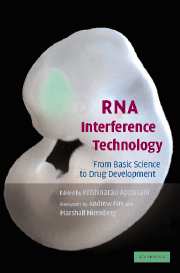Book contents
- Frontmatter
- Contents
- Foreword by Andrew Fire
- Foreword by Marshall Nirenberg
- List of Contributors
- Introduction
- Section one Basic RNAi, siRNA, microRNAs and gene-silencing mechanisms
- Section two Design, synthesis of siRNAs
- Section three Vector development and in vivo, in vitro and in ovo delivery methods
- Section four Gene silencing in model organisms
- 17 Practical applications of RNAi in C. elegans
- 18 Inducible RNAi as a forward genetic tool in Trypanosoma brucei
- 19 RNA-mediated gene silencing in fission yeast
- 20 RNA silencing in filamentous fungi: Mucor circinelloides as a model organism
- 21 RNAi and gene silencing phenomena mediated by viral suppressors in plants
- Section five Drug target validation
- Section six Therapeutic and drug development
- Section seven High-throughput genome-wide RNAi analysis
- Index
- Plate section
- References
19 - RNA-mediated gene silencing in fission yeast
Published online by Cambridge University Press: 31 July 2009
- Frontmatter
- Contents
- Foreword by Andrew Fire
- Foreword by Marshall Nirenberg
- List of Contributors
- Introduction
- Section one Basic RNAi, siRNA, microRNAs and gene-silencing mechanisms
- Section two Design, synthesis of siRNAs
- Section three Vector development and in vivo, in vitro and in ovo delivery methods
- Section four Gene silencing in model organisms
- 17 Practical applications of RNAi in C. elegans
- 18 Inducible RNAi as a forward genetic tool in Trypanosoma brucei
- 19 RNA-mediated gene silencing in fission yeast
- 20 RNA silencing in filamentous fungi: Mucor circinelloides as a model organism
- 21 RNAi and gene silencing phenomena mediated by viral suppressors in plants
- Section five Drug target validation
- Section six Therapeutic and drug development
- Section seven High-throughput genome-wide RNAi analysis
- Index
- Plate section
- References
Summary
Introduction
Different forms of RNA-mediated gene silencing, namely antisense RNA, ribozymes and double-stranded RNA (dsRNA), act in naturally occurring mechanisms of gene regulation and provide tools for artificially silencing specific genes (Brantl, 2002). Early work in bacteria indicated that RNA could act as a key regulator of complex biological systems (Itoh and Tomizawa, 1980). These observations led to the use of antisense RNA as a regulator of gene expression in both prokaryotes and eukaryotes (Izant and Weintraub, 1984; Pestka et al., 1984). Equally, characterization of plant viruses and viroids uncovered the presence of RNA sequences with the ability to catalyze degradation of homologous RNA (Forster and Symons, 1987). Adaptation of these catalytic RNAs, or ribozymes, to cleave any target sequence led to applications in both plant biotechnology and medicine (Peurta-Fernandez et al., 2003). The recent discovery of dsRNA as a key effector of RNA-directed gene silencing, in a wide range of different organisms, has revolutionized studies of gene function (Fire et al., 1998). In addition, it has provided evidence for the existence of a multi-component protein complex capable of using dsRNA signals to mediate post-transcriptional and transcriptional gene silencing (Hannon, 2002).
Model organisms have been instrumental in advancing our understanding of the mechanisms underlying different forms of gene regulation. In the area of gene silencing directed by RNA, this is best exemplified by the genetic and biochemical studies in nematodes, plants and flies, examining the mechanism of dsRNA-mediated gene regulation or RNA interference (RNAi).
- Type
- Chapter
- Information
- RNA Interference TechnologyFrom Basic Science to Drug Development, pp. 257 - 269Publisher: Cambridge University PressPrint publication year: 2005

